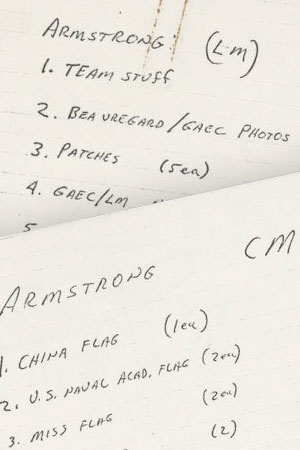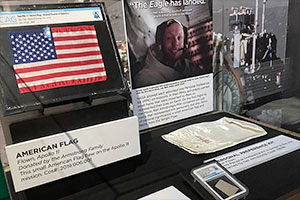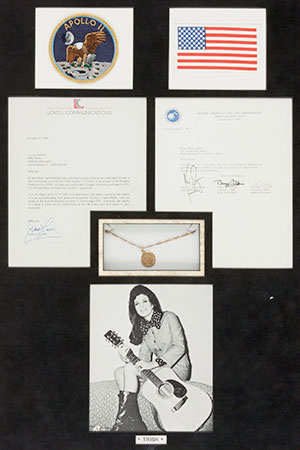July 17, 2025 — Apollo 11 astronaut Neil Armstrong launched to the moon with 280 mementos that he described as being "entirely personal." Now, his handwritten inventories of those trinkets and souvenirs have been made public for the first time.
Purdue University, where Armstrong received his undergraduate degree in 1955 and, decades later, chose to archive his papers, recently added scans of his personal preference kit (PPK) manifests to its e-Archives website. The lists are held among thousands of pages of Armstrong's speeches, correspondence and other documents from well before he became the first person to step foot on the lunar surface in 1969 through his death in 2012.
"If you were preparing to travel to space, what meaningful items would you pack for the trip?" read the post on Purdue's social media accounts on Wednesday (July 16). "We now know Neil Armstrong's answer to that question from this date 56 years ago when the Apollo 11 astronauts lifted off at Kennedy Space Center."
Some of the items listed are well documented as having flown. In an interview for his 2005 authorized biography "First Man" by historian James Hansen (later the basis for the 2018 movie of the same title starring Ryan Gosling), Armstrong said he was most proud of carrying pieces of the Wright Flyer, the first heavier-than-air vehicle to achieve powered flight in 1903.
The manifests, which are organized by the two PPK cloth pouches that Armstrong stowed on board the command module "Columbia" and one that accompanied him down to the moon on the lunar module "Eagle," list 28 pieces of wood from the plane's left propeller and a swatch of the fabric removed from the Flyer's left wing.
Those historic fragments are now in museums, including the Smithsonian National Air and Space Museum in Washington, DC. They are also in private collections, having been sold at auction for upwards of $275,000 each by Armstrong's family.
Armstrong and his Apollo 11 crewmates Buzz Aldrin and Michael Collins were also known to have packed medallions minted by the Robbins Company. Only three were struck in gold, one for each astronaut, and Armstrong's lunar module (LM) PPK list shows he flew all three (his gold medal sold for $2.055 million in 2019).
A small flag representing The Explorer's Club — entry number 11 on Armstrong's inventory of items on board Eagle — made the news when it was presented back to the esteemed organization by Armstrong's sons in 2019.
Entry 24 on the same list, "dollar bills," were launched for the National Aeronautic Association (NAA) to certify the flight. An NAA official was present when the astronauts signed the three bills before they lifted off on the mission. Afterwards, the same official recovered the dollars to serve "as the basis for certification of the identity of the astronauts," according to National Air and Space Museum where one of the bills now resides (based on the serial number recorded by Armstrong).
One of the "pins" that Armstrong listed was a replica of the gold olive branch that he and Aldrin left on the moon. Likewise, one of the "charms" was a 20 franc coin on a gold necklace that Armstrong flew for Trish Butte, "the folksinger to the astronauts," at the request of fellow astronaut Jim Lovell (the coin/charm was sold at auction for $23,900 in 2013).
Other items come as a surprise, or are so vaguely described that they cannot be immediately matched with items known to have flown.
For example, one of the mementos Armstrong packed on Columbia is identified only as a "tiki god." Similarly, entry number 20 on Eagle is listed only as a "stone."
There were items wrapped in a West Point flag that Armstrong notes belonged to Aldrin. The contents were not specified (Aldrin graduated from West Point).
And then there is the original number 22 on one of Armstrong's command module lists. He crossed it out, signaling that it did not fly, but it appears to have read "Von Braun Plate," seemingly something connected to the German rocket pioneer and NASA director, Wernher von Braun.
Accompanying Purdue's release were Armstrong's lists of what was carried for the Apollo 11 flight crew support team and the items flown at the request of NASA's public affairs office. The latter includes a kit from the U.S. Post Office Department (today the U.S. Postal Service) that held the master die for a new postage stamp commemoraing the moon landing and a postmark device, which the crew used to cancel a sample of the stamps during the flight.
The manifests were gathered together by Armstrong in 1972 at the request of NASA Administrator Jim Fletcher in response to a congressional investigation into the types of items that astronauts had been flying into space. In an accompanying letter, Armstrong wrote that his lists contained "a number of items" that he carried for NASA, its contractors and employees.
"The list would have been an order of magnitude longer if I would have agreed to each request of program officials," Armstrong wrote."In my view, NASA itself has capitalized to the greatest extent on PPK policy, and has gained the most from it." |
|

Purdue University has released astronaut Neil Armstrong's Apollo 11 personal preference kit manifests. (Purdue University/NASA)

One of Neil Armstrong's Apollo 11 personal preference kit pouches on display with a flown flag and Wright Flyer fabric. (Cosmosphere)

One of the "charms" listed in Neil Armstrong's Apollo 11 personal preference kit manifest was a franc coin flown for Trish Butte, the "folksinger to the astronauts." (Heritage Auctions) |
